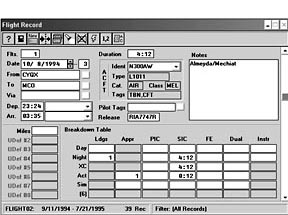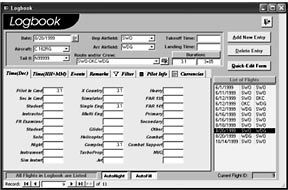Judging by the number of questions we receive about electronic logbook programs, the tedium of scribbling down flight hours must be more than many of us can bear.
A smorgasbord of computer-based products clamors to offer relief from the horror of it all. More important, however, these programs easily do the thankless task of calculating totals for insurance or new rating applications and for tracking IFR currency.
We tried several of the more popular-or at least heavily promoted-general interest aviation logbooks. Alas, all are PC only; sorry Mac owners. Several months ago, Jepp listed a Mac version on its website but that no longer shows up in the product list. Logbook programs are generally iterations of spreadsheet utilities so none of the ones we tried were unduly picky about system requirements. Most applications claim compatibility with or the availability of Palm add-ons or Pocket PC prospects, which we didnt explore. That said, we think any Windows machine should run these programs without a burp.
Because of future viability and security issues, we ignored offerings that looked like home-cooked hobby products. If you want the capability for little or no cost, by all means check some of these out. Just make sure your virus software is up to date first and don’t blame us if theyre out of business the next week.
The computer-literate can sidestep a lot of issues-not to mention cost-by creating digital record keepers. Spend some time in Excel and Access or comparable products and you may we’ll have what you need in a format thats likely to be there forever (or convertible to the latest and greatest) for the cost of only some time. The interface wont be sexy and display likely will require some scrolling, but the price is certainly right.
CaptainsLog 2000
One of the newer entrants is CaptainsLog 2000. The military market, specifically the Air Force, looks like the original impetus for this programs creation, since it will download and import AFORMS. Part 121 and 135 data fields exist, but a program actually geared for that market should be able to differentiate air time and block time.
And however cool it might be initially for the weekend puddlehopper to scroll past Combat Support or Night Sorties, thats likely to grow stale over time. Fields can be edited to track information other than the default but extraneous fields cant be eliminated.
There are yes/no fields tracking currency, but if you want to check the actual number of night landings or instrument approaches during a certain time, you have to define a new filter specific to that period or select back and forth on each flight to review manually. Too cumbersome by far for what is supposed to be a convenience product. CaptainsLog has no PDA interface option.
The price is certainly right at $29.95. Nevertheless, there are better options for the run of the mill airplane driver in our view. Give this one a pass.
Logbook Pro
New since our last logbook review is a nice product from NC Software, Inc. Excel-based Logbook Pro is unique in this group in permitting the user to specify either a window or a spreadsheet display. It will even morph the spreadsheet into Jeppesens format. The interface is attractive and intuitive, although the specialized capabilities will require some time in the help files.
Changing and deleting spreadsheet fields is a snap and those eliminated no longer clutter up the landscape. Most logbook programs now address the necessity for Part 121/135 pilots to track more than just air time, which wasnt true the last time we checked these out. Logbook Pro incorporates the appropriate columns and fields. However, the program totals takeoff to landing time only. There is no secondary hour field in the summary function which can be configured to track out and in time as well.
There are two ways to track currencies. The summary bar tucks away discreetly at the bottom, displaying a running total of flights, hours, approaches and the like for whatever periods you specify. The program will warn before expiration of currency (or not) at whatever interval and manner you select.
The analyzer is actually the filter function, which can parse practically every permutation you could need. Last 12 months should be available as a drop-down selection for insurance reports but is relatively easy to configure manually. On the other hand, Logbook Pro will render a data printout conforming to the Form 8710-1 certificate or rating application, a nice touch.
The standard edition for one user/one computer is $69.95. Pro handles one user but two synchronized computers for $99.95. The Enterprise Edition is $149.95. The Palm Companion costs an additional $29.95.
AeroLog Pro
AeroLog from Polaris Microsystems has been around in one iteration or another since 1989. The previous AeroLog for Windows was our winner in the 1999 review of logbook programs but its a 16-bit program. Although still supported, its no longer under development and isn’t guaranteed to continue operating post Windows XP.
The fourth generation AeroLog Pro (like Logbook Pro) rearranges data entry interface, with primary and supplementary views which utilize the screen more efficiently than the typical string of lateral entries. Unlike Logbook Pro, no spreadsheet iteration is available.

AeroLog is not the most intuitive among these programs, so you’ll actually want to read the instructions. On the other hand, AeroLog handles the filter function better than the others, in our view, already incorporating into the master file options for 90-day, six-month and one- year results and just about anything else youd want, including an insurance filter (which might or might not conform to your carriers requirements) and checkride form totals.
AeroLog Pro also offers an independent shift log which differentiates block and flight times, including a one-button Am I legal? check.
Another nice touch for international commercial folks is the availability of a drop down time zone list next to the departure and arrival fields. AeroLog Pro will track currency and highlight in red whats out but it wont nag you in advance.
A single installation (multiple pilots supported) of AeroLog Pro is $75 for download and an additional ten bucks each for either the CD or the printed manual. Upgrade from AeroLog for Windows starts at $30. The Palm add-on is free, a welcome feature for those who use Palms.
Jeppesen
Another contender with staying power is Jeppesens FliteLog, which began life as a Mentor product. While exclusively a spreadsheet display, Jepp makes rearranging, defeating and changing columns in FliteLog stone simple and entirely intuitive.
Block times arent included off the bat, for example, but are a snap to add. Both instrument hold and instrument tracking fields are already available for display, which is nice for those of us who can never remember to log the magic words. As with all spreadsheet displays, don’t count on being able to get everything you need onto the main screen without scrolling or tabbing.
One thing not as obvious as setting logbook columns is how to add aircraft to the library. Make sure you read the instructions, lest you morph an Aeronca into a 777. Multiple pilots are already supported without adds-on or more expensive versions.
Tracking currency is a big deal in FliteLog and, if properly set up, the program will nag..err…remind you when youre within two weeks of dropping some regulatory ball. FliteLog is a solid if unspectacular digital logbook. Unfortunately, Jeppesen has elected not to make a demo version available, unlike all the others in this review. Jeppesens FliteLog costs $89.
FlightLevel
FlightLevel 2002 is another spreadsheet-only program. Users of Excel and Access will recognize several functions and even icons. Column content and display are readily customized and extensive filter options, including user-defined fields, can be selected for customized reports. FlightLevel also allows the user to customize a variety of currency reminders. Columns are already included for Out/In, Off/On, Block and Air Time entries.
FlightLevel 2002 will support multiple pilots for the single copy $99 price. Upgrade from an earlier version is $49. The Palm Pilot and Windows CE Companion Programs are $49 each, with upgrade priced at $29. Best we could tell, there arent core functions in FlightLevel which cant be obtained in other programs for less.
Recommendations
Any of these programs will accomplish the objective, albeit with varying levels of complexity, intuitiveness and cost. For ease of entry and display, we prefer the windows type logbooks over all the scrolling or tabbing required for standard spreadsheet displays, which means Logbook Pro or AeroLog Pro.
Theyre both good programs, but the nod goes to AeroLog this round because of its longevity, treatment of Part 121/135 issues and what we view as Logbook Pros unduly pricey multiple installation and pilot options.
That said, all products except Jepp have download demos, so by all means check them out for yourself. A couple of words of warning: If importing existing data from a different program is important to you, check closely concerning the precise capabilities of both the original exported data and successor importing program, which are all over the lot. And if you need multiple pilot capabilities, pay attention to which program or which license you buy.
Whatever you do, don’t burn the paper logbook when youve finished the data input. Even if the vendor never goes defunct or abandons the product, you’ll need the instructors endorsements for all training times and sign offs, per FAR 61.51.
Also With This Article
Click here to view “Addresses.”
Click here to view “Checklist.”
-by Jane Garvey
Jane Garvey is a freelance writer and owner of a Cessna 182. Shes an Aviation Consumer contributing editor.


